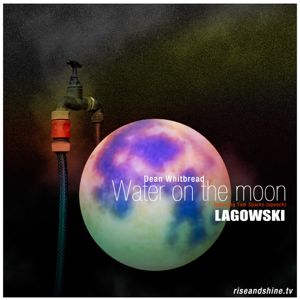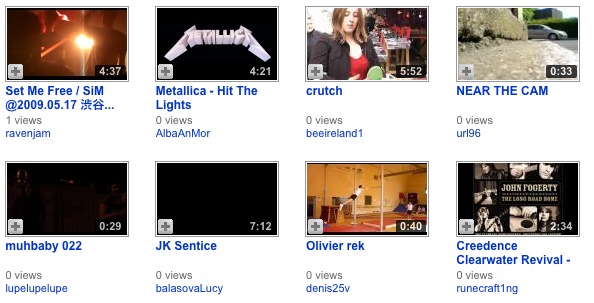Latest News
‘Rise and Shine’ Releases Podcast Remix EP
May 27th, 2009 | By Elisabeth Lewin | Category: Audio Podcasting, Digital Music, Podcasting  “Crowdsourced” songwriting podcast Rise and Shine TV has released a special 3-track EP this week, all remixes of their popular song “Water On The Moon.” The album is being published by the dPulse label, home to such artists as Adrian Belew and Digital.
“Crowdsourced” songwriting podcast Rise and Shine TV has released a special 3-track EP this week, all remixes of their popular song “Water On The Moon.” The album is being published by the dPulse label, home to such artists as Adrian Belew and Digital.
The three tracks on the mini-album include two deep remixes, titled “Drop Trajectory” and “Sparks” by “dark techno eminence” Lagowski, along with a really upbeat 145bpm “space dance mix” by Dean Whitbread, the creator or Rise and Shine. The three tracks all sound beautiful, sometimes ominous, sometimes dance-y, and all sound so different from one another (which, I guess, is the beauty of well-done remixes). The EP is available for download for $2.97.
The Rise and Shine show is a songwriting podcast that incorporates audience ideas into the daily writing of a song, and uses the proceeds from selling the songs to support music-related charities.
Previous Rise and Shine cycles included a session during the spring of this year, and a Yuletide project at the end of last year.
Zune HD: Three Strikes And You’re Out, Microsoft
May 27th, 2009 | By James Lewin | Category: iPods & Portable Media Players 
Microsoft has confirmed details on the upcoming Zune HD portable media player and, based on their announcement, it’s time to put away the Zune player under the “three strikes you’re out” rule.
Here are the highlights of the new Zune HD:
- Zune HD comes with a built-in HD Radio receiver. Users also will have access to the additional song and artist data broadcast by HD Radio stations as well as additional channels from their favorite stations multicasting in HD.
- OLED touch screen interface (480×272 resolution)
- HD-compatible output
- Full-screen Internet browser optimized for multitouch functionality.
- Zune HD is Wi-Fi enabled, allowing for streaming to the device from the more than 5 million-track Zune music store.
We’re calling this a strike – because the Zune HD is two years behind Apple’s iPhone/iPod touch platform – and Microsoft has the liability of the Zune platform’s history. The one distinguishing feature, HD Radio, is a refinement of a feature that most people have shown zero interest in.
Read more »
Is Twitter The Future Of Television?
May 26th, 2009 | By James Lewin | Category: Featured Story, Internet TV, Microblogging, Video  Twitter’s Biz Stone offers some interesting comments today on Twitter and the future of television:
Twitter’s Biz Stone offers some interesting comments today on Twitter and the future of television:
Twitter is very open. As a result, thousands of different applications, web sites, and mobile interfaces have been created by developers. These different approaches add variety and relevance to Twitter and in general make the ecosystem more interesting. However, Twitter’s openness is not limited to the web or even to mobile phones.
During the 2008 presidential elections, Hack The Debate showed us how Twitter could make television interactive and possibly even have a democratizing effect on the medium. The power of Twitter was harnessed to create new, compelling, and engaging programming. CNN was an early innovator with Twitter too. Our openness made it all possible.
Twitter’s open approach might have the power to transform television—the dominant communications receiver worldwide. We’re very excited to see where these experiments take us.
It would be a no-brainer to create a Twitter version of DiggNation. As popular as Twitter is, it would probably be an immediate hit, too.
But while DiggNation may represent a new model for media creation, Twitter has the potential to be a key facet of the future of television.
The days of televisions being broadcasting terminals are over; the future of television is open and interactive. You don’t watch TV anymore – you Twitter about it, blog about it, embed it, respond to it and remix it.
The way you watch your favorite TV show, or DiggNation for that matter, won’t be defined by the network, your cable company or by the company that made your TV; the way you watch TV will be defined by the content creator, fans of the show and you.
New Zombie Movie Takes DIY Media To An Extreme
May 25th, 2009 | By James Lewin | Category: General, Internet TV, Video
Colin is a new zombie flick that takes low-budget filmmaking to a new extreme. The movie was reportedly shot for $70, with the help of zombies found via social networking sites like Facebook:
Our hero Colin is bitten by a Zombie; he dies and returns from the dead. We follow him as he wanders through suburbia during the throes of a cadaverous apocalypse.
Shot at locations in both Wales and London, COLIN has more than its fair share of gore, along with several ambitious set pieces including a broad daylight zombie vs. human street battle and an epic housebound siege. It is also an exploration of who Colin was when he was alive through the objects, places and people he becomes attached to.
It’s too early to know if Colin will be notable for anything other than its tiny budget. As one commenter has noted, “Apparently none of the $70 was spent on the trailer.”
The Paradox Of Broadcast Television In The 21st Century
May 22nd, 2009 | By James Lewin | Category: Internet TV, Video 
One of the paradoxes of new media is that, even as people are spending more time online, even as they’re finding time to Twitter, even as they’re watching 50% more Internet video, people are watching more TV than ever.
How is this possible? Everybody’s online all the time now. When do people find time to watch four or five hours of television a day?
A new study by Solutions Research Group (SRG) suggests that people may have the TV on more than ever, but are actually watching it less. Broadcast television is taking the place of radio as the soundtrack to other activities.
According to SRG Women and Digital Life report:
- Fifty-eight percent of American women say they are spending more time with the Internet.
- 38% say their spending more time with TV.
But, while statistics show that women have the TV on more, they aren’t watching it.
“How women are watching television provides some clues as to what is going on,” notes the report. “Ambient video entertainment is now everywhere, with TV providing the background to most activities.”
Multitasking with a laptop or wireless device is now commonplace as more women have one or both devices: half of women with laptops say they have their laptops with them ‘almost always’ or ‘frequently’ when watching TV in the evening. Another 18% use their laptops when watching TV in the evening ‘occasionally.’ In addition, 52% say they are using their wireless device while watching TV at least occasionally.
TV is more likely to be “in the background†for women 25-39 (64%) and moms (65%). And considering the amount of multitasking with laptops, it’s not a big surprise that even favorite shows are watched with only partial attention by some—52% agree that “they usually pay full attention while watching their favorite shows†but 28% disagree and 19% are in between.
The television is on, but no one’s paying attention
How long do you think it will be before advertisers catch on to this? And when they do, broadcasters face the same sort of carnage that’s happening in the newspaper industry?
Online Video Advertising…Is Horrible
May 21st, 2009 | By James Lewin | Category: Featured Story, Internet TV, Video  Dan Rayburn offers a great take on the state of online video advertising in an article at BusinessOfVideo:
Dan Rayburn offers a great take on the state of online video advertising in an article at BusinessOfVideo:
The online video industry should be a lot further along then it is right now.
The consumer experience for online video advertising right now is horrible. Nearly all ads are not targeted, content owners are not making money, content owners are cutting up content into too many pieces, and while I said two years ago that “15 Second Pre-Roll Video Ads Will Become The Standard”, clearly that was wishful thinking on my part. In the last week I’ve gotten ads that range from 10 seconds, 15 seconds, 30 seconds, 41 seconds and 60 seconds.
What is going on? How do content owners not realize the affect this has on the consumer experience?
Rayburn’s right. The state of Internet video advertising is horrifically bad.
We already know that ad-supported Internet video is the future.
We already know that traditional 30-second commercials don’t work online.
We already know that bad advertising is holding back Internet video.
So why are sites like Hulu still torturing us with long, untargeted ads?
Don’t advertisers know that we’re muting the sound and checking our email or Twittering about how bad their ads are?
Image: JPDaigle
YouTube Growing By 20 Hours Of Video Every Minute
May 21st, 2009 | By James Lewin | Category: Internet TV, Video  YouTube Product Manager Ryan Junee shared an interesting stat today: YouTube users are uploading 20 hours of video every minute, on the average:
YouTube Product Manager Ryan Junee shared an interesting stat today: YouTube users are uploading 20 hours of video every minute, on the average:
In mid-2007, six hours of video were uploaded to YouTube every minute. Then it grew to eight hours per minute, then 10, then 13. In January of this year, it became 15 hours of video uploaded every minute, the equivalent of Hollywood releasing over 86,000 new full-length movies into theaters each week.
Now, 20 hours of video are uploaded to YouTube every minute, and it is a testament to the fact that you’ve made YouTube your online video home.
What makes this even more amazing is that the site works, in spite of the fact that most of the video uploaded to YouTube is mind-numbingly dull:

YouTube’s success comes, not from the mass of video that is getting uploaded to the site, but from the fact that YouTube make it easy for you to find content that’s of interest to a broad range of people.
This is a key challenge of user-generated media, and YouTube and Apple, with it’s iTunes podcast directory, have demonstrated how doing this well can be a key competive advantage.
Nielsen: Internet Video Viewing Up 50 Percent
May 20th, 2009 | By Elisabeth Lewin | Category: Video  American television consumption is on the rise, on every platform available, according to a new report from The Nielsen Company. Monthly time spent watching video on the Internet grew especially quickly, up over 50 percent since the first quarter of last year.
American television consumption is on the rise, on every platform available, according to a new report from The Nielsen Company. Monthly time spent watching video on the Internet grew especially quickly, up over 50 percent since the first quarter of last year.
Nielsen’s quarterly “Three Screen Report” looks at Americans’ media consumption habits, and this latest edition reveals that the average American watches a staggering 153 hours of TV every month at home, a 1.2% increase from last year.
The Internet video-watching numbers are dwarfed in comparison: the 131 million Americans who do watch video on the Internet watch an average of only about three hours of video online each month (both at home and at work.) However, this figure is still significantly higher than the average hour and 57 minutes people spent watching Internet video each month, during the same time period last year.
The 13.4 million Americans who watch video on mobile phones watch on average about 3 ½ hours of mobile video each month, but figures for mobile video watching were not tracked at this time last year, so one can’t examine how and whether that figure is greater than during the same time in 2008.
Neilsen credits “strong brand marketing” and big news events like the Super Bowl and the Presidential Inauguration with the strong growth in online video-watching during the first-quarter of 2009. They forecast continued growth in Internet video audiences, as more people get broadband Internet connections and computer hardware with better video-streaming capabilities.
The report also forecasts growth in mobile video consumption, with more and better mobile content available, and the rise of the mobile web as a viewing option. A more detailed explanation of Neilsen’s “Three Screen Report” can be found here.
Webster: Future of Podcasting Lies In Original, Bite-Size Content
May 20th, 2009 | By Elisabeth Lewin | Category: Podcasting, The New Media UpdateTom Webster of Edison Research has a thought-provoking piece on the future of podcasting.
At his blog, The Infinite Dial, Webster qualifies the cup-is-half-empty findings of the Zenith Optimedia report (as detailed by eMarketer). To review, Zenith sees the future of podcasting as rosy and profitable only for the lucky few, and podcasting ad revenue will remain a small piece of the total online advertising pie.
Webster, on the other hand, points out (with some fun “Terminator” references) that an alternate future is possible for podcasting. He says that podcasting today, in his view, falls into the niche, “indie” camp, or into the big bin of repurposed content from “mainstream producers.” Most niche content, being niche, won’t attract a huge audience (or huge revenues). Repurposed old-media content won’t yield new audiences or drive income growth, in Webster’s view.
So, how to make the best use of “unique attributes of the [podcast] medium” and spark growth in both the audience size and the market for downloadable media? Webster says to think PODCASTING:
P: Portable. More than two-thirds of podcast consumers continue to report listening more to podcasts tethered to their computer (where they compete with everything) than they do on portable devices–where new listening opportunities for broadcast content abound. Location-specific, activity-specific and context-specific content opens up all kinds of creative programming and revenue opportunities.
O: Original. Content that you can’t get anywhere else, like the unaired “fourth hour” of your morning show, local music features, or local public affairs programming–basically, anything you can think of that won’t fly as broadcast, mass-appeal content that nevertheless has a place with passionate sub-groups of your audience.
D: Discrete. Think “Song,” not necessarily “Show.” Bite-sized, easily digestible content chunks allow the podcast listener/viewer to create their own ‘playlist’ of content. I rarely miss Jon Gordon’s “Future Tense” or my friend Chris MacDonald’s IndieFeed podcasts because they are both around five minutes long, and I can easily stick them in the same playlist for my morning run.
C: Compelling. Goes without saying.
ASTING: I got nothin’. OK, you really only need to tackle the first four.
The suggestions are sensible, and content producers should take many of these ideas to heart. But the arguments overlook or exclude some of the best things about podcasting as the medium stands today.
For example, “This American Life” is, essentially, just a podcast edition of its weekly public radio program. But while the radio audience for the show has levelled at (a respectable) 1.8 million, the podcast of the show has gained a half a milliion listeners who otherwise would not be listening to the show. And the show ignores the “bite size” caveat, weighing in at an hour per episode.
What do you see as the podcasting “success stories” of today? What “rules” would you lay down to assure that the downloadable media industry thrives and grows?
YouTube In Talks To Offer Full-Length Shows In UK
May 20th, 2009 | By Elisabeth Lewin | Category: Streaming Video, Video  New Media Age is reporting that video giant YouTube is working on a plan to offer popular full-length television shows to viewers in the United Kingdom. Talks are said to be underway between YouTube and British TV networks Channel 4 and ITV, and with Sony Pictures, for rights to stream those companies’ programs.
New Media Age is reporting that video giant YouTube is working on a plan to offer popular full-length television shows to viewers in the United Kingdom. Talks are said to be underway between YouTube and British TV networks Channel 4 and ITV, and with Sony Pictures, for rights to stream those companies’ programs.
NMA calls YouTube’s actions “a scramble,” as the Google-owned video site is racing against CBS-owned TV.com and Hulu.com to be the first major “long-form” streaming video provider in the country.
The market for video-on-demand in the UK is wide open: An nascent joint venture between Channel 4, ITV, and BBC Worldwide (the commercial part of BBC), nicknamed “Project Kangaroo,” was scuttled in February by the country’s Competition Commission. It was feared that the combined power of those three companies (and their extensive content catalog) would pose an “unfair threat to competition” by other VOD providers.
NMA reports that YouTube will be “kicking off a service in the UK which will then be rolled out to five European territories.”
Even if YouTube becomes the first major commercial entrant in to the UK long-form video race, it will still have to become more effective at making money with its extensive TV offerings. In the United States, YouTube is far and away the most-used streaming video site, with over 40 percent of all online video being viewed on that site. Yet, the cost to service that huge video demand, without an effective revenue model, has caused the company to lose approximately $470 million in the past year.
